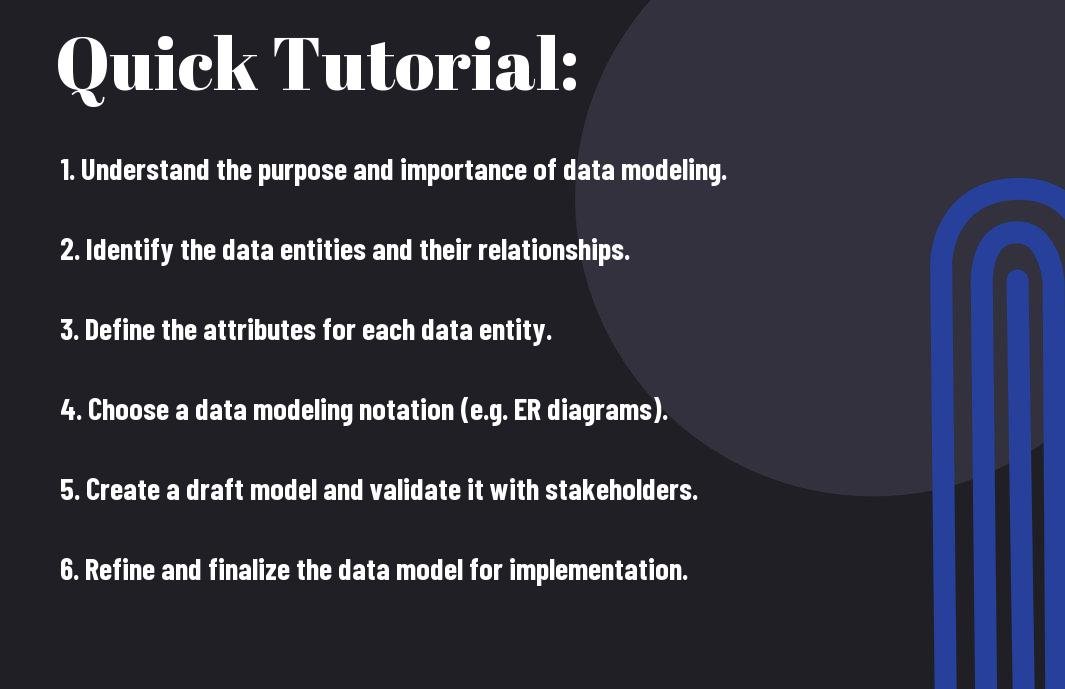Understanding the Basics of Data Modeling
For a beginner in the field of data management or database design, the concept of data modeling can seem overwhelming. However, with the right guidance and understanding of the basics, data modeling can be an accessible and valuable skill to possess.
Defining Data Modeling: What It Is and Its Importance
One of the foundational concepts in database management, data modeling is the process of creating a visual representation of the organization’s data and how it is used. By defining the structure of the data, relationships between data elements, and the business rules that govern the data, data modeling helps in creating a blueprint for constructing databases.
Data modeling is important because it acts as a communication tool between business stakeholders and technical teams. It enables a common understanding of data requirements and ensures that databases are designed to meet the needs of the organization.
The Evolution of Data Modeling: A Historical Overview
Overviewing the history of data modeling provides insights into its development alongside technological advancements. From the early days of file-based systems to the sophisticated databases of today, data modeling has evolved to meet the growing demands of businesses in managing and utilizing their data.
To fully grasp the significance of data modeling, it is crucial to understand its journey through various technological eras and the impact it has had on database development, maintenance, and scalability.
Types of Data Models: Conceptual, Logical, and Physical Explained
Any discussion of data modeling must include an exploration of the three primary types of data models: conceptual, logical, and physical. These models serve different purposes and cater to different audiences within an organization, yet they are interconnected in the overall data management process.
- Conceptual data models focus on high-level business concepts and relationships.
- Logical data models delve into the details of the data elements and how they relate to each other.
- Physical data models represent the actual implementation of the database on a specific database management system.
Plus, it is important to understand how these models interact and evolve throughout the database design process to ensure a robust and efficient database structure.
Key Takeaways:
- Data modeling is the process of creating a visual representation of data and its relationships to help organizations understand and use their data more effectively.
- Identifying entities and attributes is a crucial first step in data modeling, as it helps to define the data that an organization needs to store and manage.
- Relationships between entities are important to understand in data modeling, as they help to define how different pieces of data are connected and relate to each other.
- There are different types of data models, such as conceptual, logical, and physical models, each serving a specific purpose in the data modeling process.
- Data modeling tools can help streamline the process and make it easier to create, modify, and communicate data models within an organization.
- Normalization is a key concept in data modeling that helps ensure data is organized efficiently and accurately, reducing redundancy and improving data integrity.
- Data modeling requires collaboration between various stakeholders, including business analysts, database administrators, and data architects, to ensure that the resulting data model meets the organization’s needs.

The Components of Data Modeling
While data modeling may seem daunting at first, it is actually a systematic process that involves several key components. Understanding these components is crucial for anyone looking to master the art of data modeling.
Entities, Attributes, and Relationships: The Building Blocks
With data modeling, the primary focus is on identifying entities, which are the real-world objects or concepts with characteristics and properties that we want to capture in our database. Each entity is described using attributes, which represent the specific data points associated with the entity. Relationships then define how different entities are connected to each other, creating the structure and logic of the data model.
With proper identification and definition of entities, attributes, and relationships, data modeling becomes a precise and efficient process. It is the foundation on which the entire database is built, and getting these building blocks right is crucial for the success of the data model.
Keys and Indexes: Ensuring Data Integrity and Performance
For data to be organized and retrieved efficiently, keys and indexes play a crucial role in data modeling. Keys are used to uniquely identify each record in a table, ensuring data integrity and relational consistency. Meanwhile, indexes are structures that help speed up data retrieval operations, making queries perform faster and more efficiently. By defining the right keys and creating the appropriate indexes, data modeling ensures both the accuracy and performance of the database.
Data integrity and performance are fundamental aspects of data modeling, and the strategic use of keys and indexes is essential for achieving them. Understanding how to implement and optimize keys and indexes is a vital skill for any data modeler, as it directly impacts the overall usability and effectiveness of the database.
Tutorial Steps: Crafting Your First Data Model
Keep reading as we dive into the step-by-step process of crafting your first data model. Understanding the intricacies of data modeling is essential for anyone looking to make sense of complex data structures and relationships. Whether you’re a beginner or seeking to refresh your knowledge, this guide will equip you with the essential skills to create effective data models.
Step 1: Requirements Gathering – Understanding What to Model
Understanding the specific requirements of your data model is the foundational step in the data modeling process. This involves analyzing and gathering information about the business needs, user interactions, and data sources that will drive the design of your model. Paying close attention to the scope and purpose of the data model will help you determine what entities, attributes, and relationships need to be represented.
Step 2: Selecting the Type of Data Model
Analysis of your data requirements will guide you in selecting the most suitable type of data model for your project. Whether it’s a relational, hierarchical, network, or object-oriented data model, each type has its own strengths and weaknesses. Stepping back to evaluate the nature of your data and the way it needs to be manipulated will allow you to make an informed decision about the type of data model that best fits your needs.
Step 2: Selecting the Type of Data Model is a crucial decision that impacts the effectiveness and efficiency of your data management. It is important to consider the scalability, performance, and flexibility of the data model to ensure that it can meet present and future requirements.
Step 3: Building the Model
To build the data model, you will transition from gathering and analysis to crafting the actual structure. This involves defining entities, attributes, and relationships in a way that accurately reflects the real-world data and its inherent patterns. The ability to translate the gathered requirements and selected data model type into a comprehensive and logical model is essential.
First and foremost, it’s important to ensure that the model is designed to optimize the querying and manipulation of data, while facilitating maintenance and updates as needed.
Advanced Topics in Data Modeling
Unlike basic data modeling concepts, advanced topics in data modeling delve into more complex and specialized areas. This includes techniques for data modeling in big data environments, adapting data modeling strategies for NoSQL databases, and integrating data modeling into agile development processes. Here, we will explore these advanced topics in detail.
- Data Modeling for Big Data: Techniques and Best Practices
- Data Modeling in the Age of NoSQL Databases
- Integrating Data Modeling in Agile Development Processes
Data Modeling for Big Data: Techniques and Best Practices
With the advent of big data, traditional data modeling techniques have had to evolve to accommodate the unique challenges posed by massive volumes of unstructured data. Techniques such as schema-on-read, data lake modeling, and distributed data modeling have emerged as best practices in big data environments. These techniques focus on scalability, performance optimization, and flexibility to effectively model and manage big data.
Advanced data modeling tools and platforms, such as Apache Hadoop and Apache Spark, offer capabilities for big data modeling, including parallel processing, distributed data storage, and data processing frameworks. Utilizing these tools and techniques requires a deep understanding of parallel computing, distributed systems, and advanced statistical analysis to derive meaningful insights from big data.
Data Modeling in the Age of NoSQL Databases
Modeling data in the context of NoSQL databases introduces a paradigm shift from the traditional relational database model. NoSQL databases offer flexible schema and horizontal scalability, allowing for efficient management of semi-structured and unstructured data. However, this flexibility also introduces challenges in maintaining data consistency and ensuring data integrity across distributed systems.
For instance, NoSQL data modeling techniques such as document store modeling, key-value store modeling, and wide-column store modeling require a different approach to structuring data compared to traditional SQL databases. Understanding the trade-offs and implications of these modeling techniques is essential for maximizing performance and minimizing data redundancy in NoSQL environments.
Integrating Data Modeling in Agile Development Processes
Advanced data modeling principles can be seamlessly integrated into agile development processes to ensure that data modeling aligns with the iterative and adaptive nature of agile methodologies. This integration involves collaboration between data modelers, developers, and business stakeholders to continuously refine and evolve the data model based on changing requirements.
The iterative nature of agile development allows for rapid prototyping and feedback loops in data modeling, enabling the identification and resolution of potential issues early in the development cycle. By incorporating data modeling into agile processes, organizations can improve data quality and accelerate development timelines while maintaining flexibility to adapt to evolving business needs.
Tools and Software for Effective Data Modeling
Not all data modeling tools are created equal. In fact, the right tools and software are crucial for effective data modeling. In this chapter, we will explore the different types of data modeling tools, criteria for selecting the right software, and a tutorial for getting started with a data modeling tool.
Overview of Data Modeling Tools
Effective data modeling tools come in various forms, including database design tools, ER diagram tools, and data modeling software. These tools are essential for creating visual representations of data structures, relationships, and entities within a database. They help data modelers and database developers to conceptualize and design databases, as well as communicate with stakeholders and developers.
When choosing a data modeling tool, it is important to consider factors such as ease of use, compatibility with existing systems, collaboration features, and support for industry standards. Additionally, some tools offer advanced features such as reverse engineering, forward engineering, and data dictionary management, which can significantly streamline the data modeling process.
Criteria for Selecting the Right Data Modeling Software
Modeling software, it is important to consider the specific needs of your organization and project. Criteria such as scalability, cost, learning curve, and technical support are crucial for making the right choice. Additionally, consider whether the software supports the database management systems (DBMS) and data modeling notations that are commonly used within your organization or industry.
This careful consideration ensures that the selected data modeling software aligns with the long-term goals of the organization and allows data modelers to efficiently and accurately create and maintain data models.
Tutorial: Getting Started with a Data Modeling Tool
Modeling tools can seem intimidating at first, but with the right guidance, you can quickly become proficient in using them. In this tutorial, we will walk through the basic steps of creating a simple data model using a popular data modeling tool. By the end of this tutorial, you will have the knowledge and confidence to start creating your own data models.
Started with a data modeling tool is an essential skill for anyone working with databases, and this tutorial will empower you to take control of your data modeling projects.
Common Data Modeling Challenges and How to Overcome Them
Despite advancements in technology, data modeling still presents several challenges for beginners and experienced professionals alike. However, with the right approach, these challenges can be effectively overcome. In this chapter, we will explore the common data modeling challenges and provide practical solutions for addressing them.
Handling Complex Relationships and Dependencies
Handling complex relationships and dependencies in data modeling can often lead to confusion and inefficiencies. One way to overcome this challenge is to break down the complex relationships into smaller, more manageable parts. By identifying the primary entities and their direct relationships, data modelers can create a clearer structure for the data. Additionally, the use of relationship tables and normalization techniques can help simplify complex relationships, making them easier to manage within the data model.
Another approach to overcoming complex relationships and dependencies is to leverage visualization tools and techniques. Visualizing the relationships through entity-relationship diagrams or other modeling tools can provide a clear and intuitive representation of the data structure. This not only helps in understanding the relationships better but also aids in communicating the model to stakeholders.
Ensuring Scalability and Performance
To ensure scalability and performance in data modeling, it is essential to consider the volume and velocity of data that the model will encounter. One approach is to design the data model in a way that allows for horizontal scalability, enabling the system to handle growing amounts of data by adding more resources or nodes. Additionally, optimizing query performance through indexing and partitioning can significantly improve the overall system responsiveness.
Plus, utilizing caching mechanisms and data denormalization can further enhance the system’s performance. Caching frequently accessed data can reduce the load on the underlying storage, while denormalizing certain parts of the data can speed up query execution by reducing join operations.
Adapting to Changing Business Requirements
An essential aspect of data modeling is its ability to adapt to evolving business requirements. This can be achieved by establishing a flexible and extensible data model that accommodates changes without requiring a complete overhaul. Implementing agile modeling techniques and maintaining clear documentation can facilitate seamless adjustments to the data model as the business needs evolve.
For instance, incorporating version control and change management processes can ensure that modifications to the data model are tracked and approved, minimizing the risk of erroneous changes. By staying proactive and responsive to changing business requirements, data modelers can create a robust foundation for the organization’s data management needs.
Case Studies: Real-World Examples of Data Modeling Success
Your journey into understanding data modeling wouldn’t be complete without taking a closer look at some real-world case studies. These examples will illustrate how data modeling has been successfully applied across various industries to optimize processes, enhance decision-making, and improve overall performance.
- E-commerce Data Model: Facilitating Online Transactions
- Healthcare Data Model: Streamlining Patient Care
- Retail Data Model: Enhancing Customer Experience
E-commerce Data Model: Facilitating Online Transactions
An
Healthcare Data Model: Streamlining Patient Care
Data
To understand the significance of data modeling in healthcare, let’s explore how it has been used to improve patient care and optimize operational efficiency.
Retail Data Model: Enhancing Customer Experience
Healthcare
Success in the retail industry heavily relies on understanding customer behavior and preferences. This is where data modeling steps in, driving personalized marketing strategies and inventory management to a whole new level of effectiveness.

FAQ
Q: What is data modeling?
A: Data modeling is the process of creating a visual representation of the data and its relationships within an organization. It helps in understanding the data requirements and designing an effective database structure.
Q: Why is data modeling important?
A: Data modeling is important as it helps in ensuring data accuracy, consistency, and integrity. It also aids in communication between business stakeholders and technical teams, leading to better decision-making and efficient system development.
Q: What are the key components of data modeling?
A: The key components of data modeling include entities, attributes, relationships, and constraints. Entities are the objects or concepts about which data is stored, attributes are the properties of entities, relationships define how entities are related, and constraints ensure data integrity.
Q: What are the common data modeling techniques?
A: Common data modeling techniques include Entity-Relationship (ER) modeling, Dimensional modeling, and Object-oriented data modeling. Each technique has its strengths and is chosen based on specific project requirements.
Q: How can I learn data modeling as a beginner?
A: As a beginner, you can start by understanding the basics of databases and then gradually learn about data modeling concepts, tools, and best practices. There are several online resources, courses, and books available to help you kickstart your journey in data modeling.







